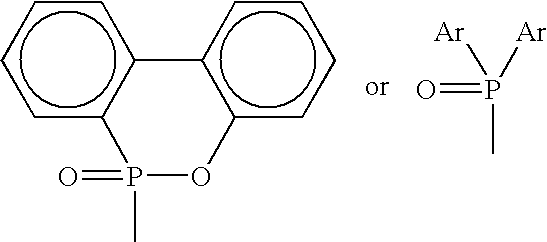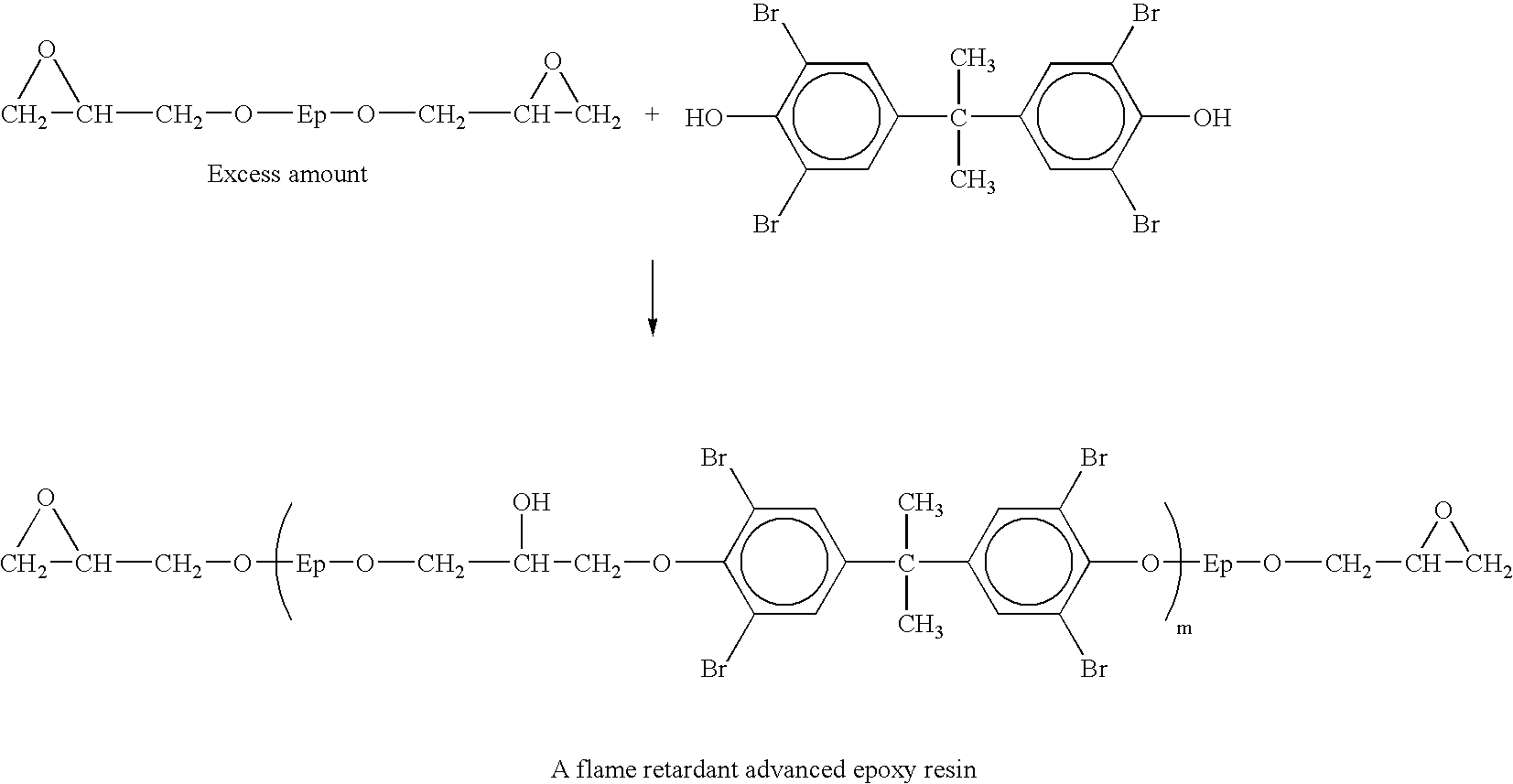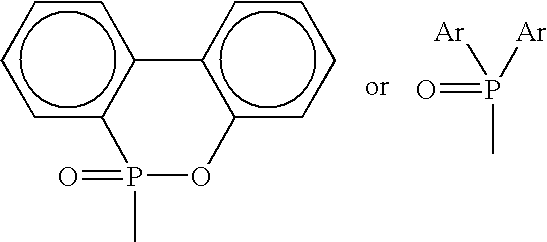Phosphorus-containing flame-retardant hardener, and epoxy resins cured by the same
a flame-retardant hardener and phosphorus technology, applied in the field of active hydroxide-containing phosphorus compounds, can solve the problems of high temperature, high glass transition temperature (tg), and generation of toxic and corrosive fumes in devices, and achieve high decomposition temperature, high elastic modulus, and high glass transition temperature
- Summary
- Abstract
- Description
- Claims
- Application Information
AI Technical Summary
Benefits of technology
Problems solved by technology
Method used
Image
Examples
preparation example 1
[0039]To a one liter four-inlet flask equipped with a temperature controller, a reflux condenser, a nitrogen feed and a mechanical stirrer, 1 mole (216 g) of 9,10-dihydro-9-oxa-10-phosphaphenanthrene-10-oxide (DOPO, purchased from TCI Co.) and 500 ml xylene were added. The mixture was heated to 50° C. and then stirred. The mixture was heated to a temperature of 90° C. and the stirring was continued until DOPO was dissolved completely. To this solution was added slowly 1.0 mole (30 g) formaldehyde within one hour, and the temperature thereof was increased to 110–115° C. and maintained at that temperature for four hours after the addition of formaldehyde was completed. The mixture was then cooled to room temperature, filtered, and purified with tetrahydrofuran (THF) to obtain 2-(6-oxido-6H-dibenzoxa-phosphorin 6-yl) methanol [ODOPM; (I)]. Yield, 92%; m.p. 152–154° C. Anal. Calcd. for C13H11PO3: C, 63.41; H, 4.47; O, 19.51; P, 12.61. Found: C, 63.32; H, 4.51; O, 18.93; P, 13.24. EIMS, ...
preparation example 2
[0040]To a one liter four-inlet flask equipped with a temperature controller, a reflux condenser, a nitrogen feed and a mechanical stirrer, 1 mole (216 g) DOPO and 500 ml THF were added. The mixture was heated to 50° C. and then stirred. The mixture was heated to a temperature of 70° C. and the stirring was continued until DOPO was dissolved completely. To this solution was added slowly 1.0 mole (58 g) acetone within two hours, and the temperature thereof was increased to 70° C. and maintained at that temperature for four hours after the addition of acetone was completed. The mixture was then cooled to room temperature to obtain white solid, which was then filtered, and purified with THF to yield 2-[2-(6-oxid-6H-dibenzoxa-phosphorin-6-yl)]propan-2-ol [ODOPP; (I)]. Yield, 96%; m.p. 128–130° C. Anal. Calcd. for C15H15PO3: C, 65.69; H, 5.47; O 17.52; P, 11.32. Found: C, 65.61; H, 5.52; O, 17.36; P, 11.51. EIMS, m / z: 274 (92. M+).
preparation example 3
[0041]To a one liter four-inlet flask equipped with a temperature controller, a reflux condenser, a nitrogen feed and a mechanical stirrer, 1 mole (216 g) DOPO and 500 ml p-chloro nitrobenzene were added. The mixture was heated to 50° C. and then stirred. The mixture was heated to a temperature of 90° C. and the stirring was continued until DOPO was dissolved completely. To this solution was added slowly 1.0 mole (72 g) 2-butanone within two hours, and the temperature thereof was increased to 120–125° C. and maintained at that temperature for six hours after the addition of 2-butanone was completed. The mixture was then cooled to room temperature to obtain white solid, which was then filtered, and purified with THF to yield 2-[2-(6-oxid-6H-dibenzoxa-phosphorin-6-yl)]butan-2-ol [ODOPB; (I)]. Yield, 92%; m.p. 101–103° C. Anal. Calcd. for C16H17PO3: C, 66.67; H, 5.90; O, 16.66; P, 10.77. Found: C, 66.59; H, 5.97; O, 16.45; P, 10.99. EIMS, m / z: 288 (96. M+).
PUM
| Property | Measurement | Unit |
|---|---|---|
| temperature | aaaaa | aaaaa |
| temperature | aaaaa | aaaaa |
| temperature | aaaaa | aaaaa |
Abstract
Description
Claims
Application Information
 Login to View More
Login to View More - R&D
- Intellectual Property
- Life Sciences
- Materials
- Tech Scout
- Unparalleled Data Quality
- Higher Quality Content
- 60% Fewer Hallucinations
Browse by: Latest US Patents, China's latest patents, Technical Efficacy Thesaurus, Application Domain, Technology Topic, Popular Technical Reports.
© 2025 PatSnap. All rights reserved.Legal|Privacy policy|Modern Slavery Act Transparency Statement|Sitemap|About US| Contact US: help@patsnap.com



